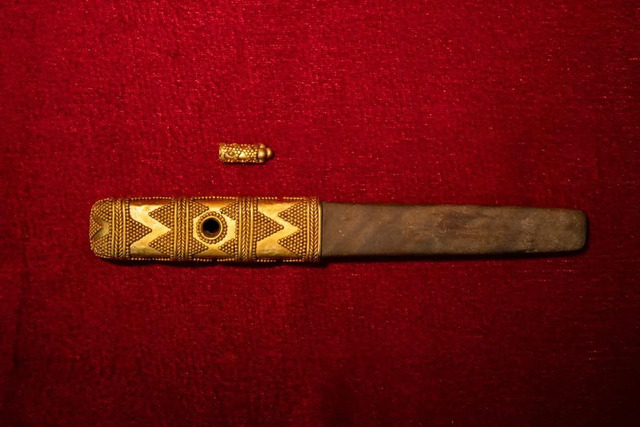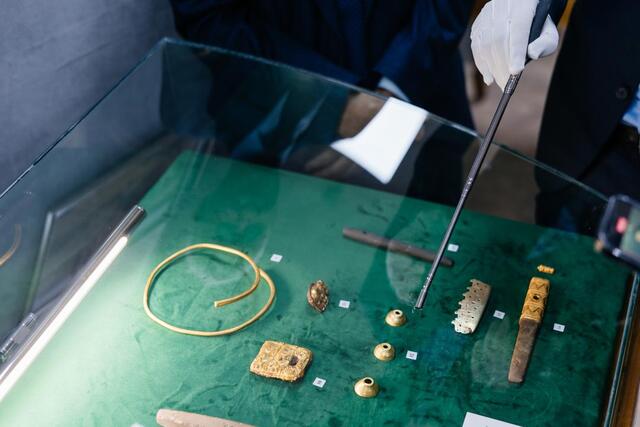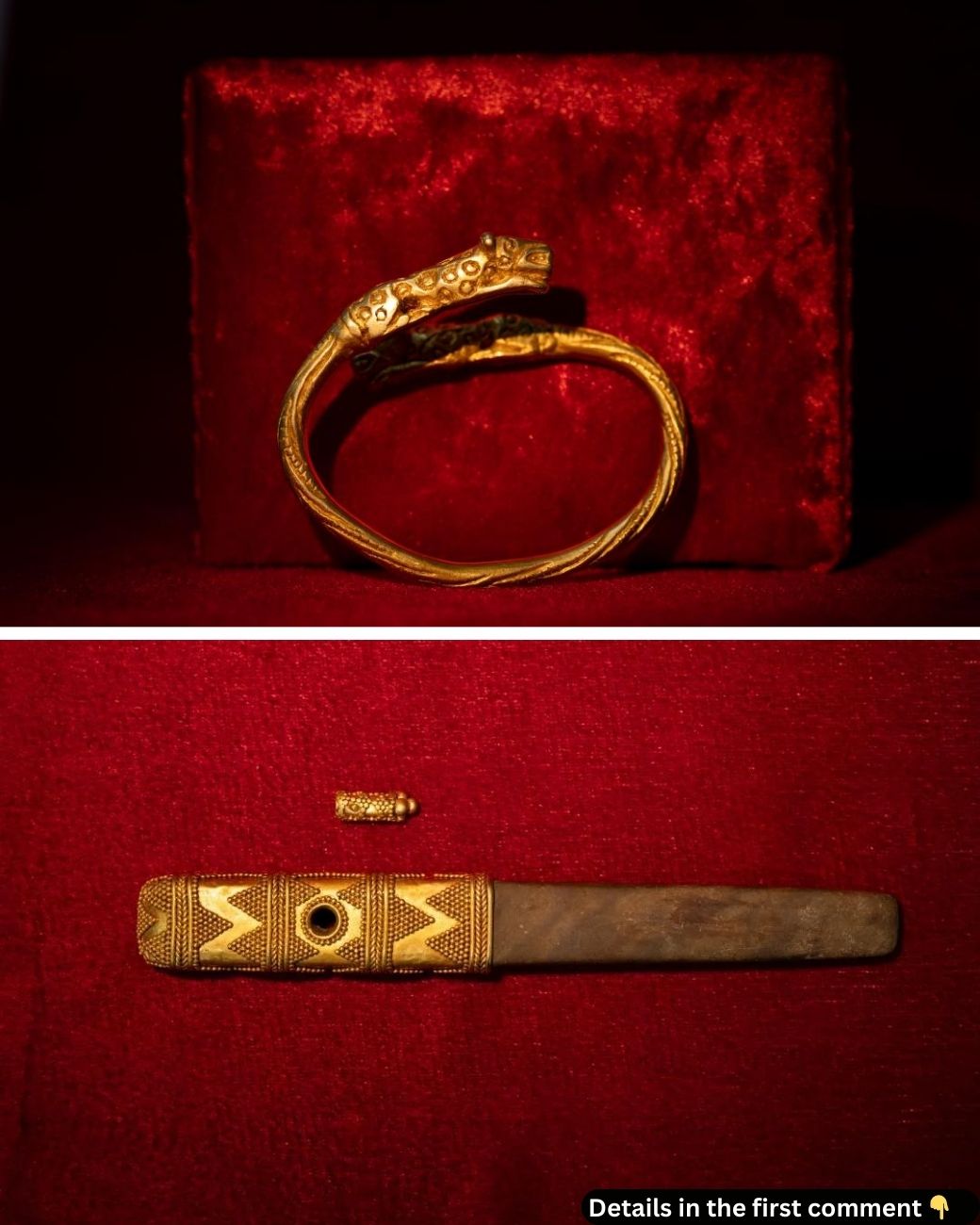In the vast steppes of Kazakhstan, archaeologists have unearthed a treasure trove of Sarmatian artifacts, shedding new light on an ancient civilization that once dominated the Eurasian plains. From gold jewelry to iron weapons, these discoveries challenge long-held perceptions of the Sarmatians as a peripheral people. Dating back to the 5th century BCE, the findings from burial mounds reveal a rich culture of artistry, warfare, and high status, offering a glimpse into the lives of Sarmatian elites and their complex society. The excavation uncovers a story that has long remained buried beneath the soil.
Excavation Site and Methodology
The focus of the excavation was the Karabau-2 burial mound, located in the Qyzylqoga district, about 10 kilometers north of the village of Karabau. Measuring 70 meters in diameter and rising three meters in height, the mound was one of the most prominent in the area. Excavations, carried out from 2023 to 2024, revealed nine graves, seven of which were exceptionally well-preserved.
The grave goods found within these mounds—gold jewelry, weapons, and ceramics—are key to understanding the role of the Sarmatians in the ancient world. The excavation also extended to the adjacent Karakuduk-1 and Karakuduk-2 mounds, where further graves containing similar artifacts were uncovered. The meticulous work was carried out by a team of 20 workers, alongside anthropologists from Astana and Almaty, with findings being shared at the “Sarmatian Gold” exhibition.


Video
Watch 370 Grams of Gold Bracelet, and Burial Sites Discovered in Kazakhstan’s Atyrau Region to uncover these remarkable archaeological finds. A fascinating look into ancient history!
Remarkable Discoveries: Jewelry, Weapons, and Ceramics
One of the most striking discoveries was a 370-gram gold bracelet adorned with elaborate depictions of mountain leopards, an animal commonly associated with Sarmatian royalty. This bracelet, along with more than 100 other gold ornaments, provides an extraordinary window into the Sarmatians’ artistic traditions.
The animalistic designs, featuring leopards, wild boars, and tigers, reflect both the nomadic lifestyle and the symbolic meanings these animals held within Sarmatian culture. In addition to the jewelry, the excavation uncovered iron and bronze weapons, including swords and spears, indicating the martial prowess of the Sarmatians.

The presence of two exceptionally well-preserved wooden bowls, an extraordinary rarity in Kazakhstan due to the rapid decay of wood in the region, further highlights the quality of preservation at this site. Two black touchstones with gold handles, likely used for testing the purity of gold, were also recovered, shedding light on the Sarmatians’ advanced metalworking techniques.
Cultural Insights: Sarmatian Society and Beliefs
The Sarmatians were a highly mobile and warrior-centric society, with a deep connection to the land they traversed. They were known for their skills as horse riders and for their ability to navigate the vast steppes of Eurasia. As a nomadic culture, the Sarmatians were likely influenced by the Tengrist religious beliefs that were prevalent among other nomadic groups in the region.

The excavation finds—especially the gold jewelry and weapons—suggest that the Sarmatians valued both artistic expression and the ability to defend their communities. The practice of placing personal belongings such as weapons and ornamentation in graves reflects their belief in the afterlife, where such items would be needed for the journey beyond. The burial customs observed at the Karabau-2 site offer a glimpse into the religious and social structure of Sarmatian society.
The Role of Sarmatian Art and Symbolism
The animal motifs found in the jewelry and other artifacts provide a window into the symbolic universe of the Sarmatians. The frequent depictions of mountain leopards, wild boars, and tigers suggest that these animals were not only important for their symbolic meaning but also for their role in the Sarmatians’ daily lives. The leopard, for example, may have represented strength and agility, qualities valued by a people whose survival depended on their prowess in battle and in hunting. The Sarmatians’ art, as seen in their metalwork and ceramics, was not just for decoration; it was a reflection of their beliefs and their understanding of the natural world. The intricate craftsmanship of these items, particularly the gold jewelry, underscores the Sarmatians’ expertise in metallurgy and their cultural sophistication.
Royal Burials: Insights into Sarmatian Hierarchy
The discovery of the Karabau-2 kurgan, with its well-preserved graves and rich assortment of artifacts, suggests that this burial mound was reserved for high-status individuals, possibly even royalty. Archaeologists have identified the graves as belonging to Sarmatian elites, with the presence of valuable objects such as gold jewelry and weapons reinforcing the idea that these individuals were not ordinary members of society.
The collective burial practices found at the site indicate a hierarchical social structure, where important figures were buried with grave goods that reflected their status and influence. The close proximity of the Karabau-2 mound to other significant burial mounds further supports the idea that this area was a key center of Sarmatian society, with these burial sites serving as focal points for social and religious activities.
New Understanding of the Sarmatian Empire’s Geography
Historically, the Sarmatians have been viewed as a peripheral civilization, occupying the fringes of the ancient world. However, the recent discoveries in the Atyrau region challenge this view, suggesting that the area was not on the outskirts but at the heart of Sarmatian culture. The region’s strategic location near the Caspian Lowland, Zhaiyk River, and Zhem River made it an ideal center for the Sarmatians to establish trade and military dominance. These rivers provided not only fertile land but also easy access to key trade routes that connected the Sarmatians with neighboring civilizations such as the Persians and the Scythians. The findings from the Karabau-2 and surrounding mounds offer a new perspective on the importance of this region in Sarmatian history, highlighting its role as a thriving hub of cultural and economic activity.
The “Sarmatian Gold” Exhibition: Bringing History to the Public

The excavation findings were presented to the public at the “Sarmatian Gold” exhibition, which allowed experts to share their discoveries with a wider audience. The exhibition showcased the intricate gold jewelry, weapons, and other artifacts, offering a tangible connection to the Sarmatians’ past. The exhibition emphasized the significance of these findings in reshaping our understanding of the Sarmatians and their cultural contributions. Regional officials, historians, and cultural experts gathered at the event to discuss the implications of the discovery, with many highlighting how these findings challenge previous assumptions about the Sarmatians as a peripheral civilization.
Future Prospects: What Lies Ahead in Sarmatian Research?
The excavation of the Sarmatian burial mounds in the Atyrau region is far from over. Archaeologists believe that there are many more mounds yet to be uncovered, each potentially holding further clues about the lives and customs of this ancient people. Ongoing research will continue to explore the full extent of the Sarmatian presence in the region, with a particular focus on the social and cultural dynamics that shaped their civilization. The discovery of additional burial sites, along with the analysis of the artifacts already uncovered, promises to reveal more about the Sarmatians’ interactions with neighboring cultures and their contributions to the broader history of Eurasian nomadic peoples.
Video
Watch Priceless Ancient Gold Jewelry Found in Kazakhstan to explore this incredible discovery of ancient treasures. A fascinating glimpse into the past!
Conclusion: A Rediscovered Civilization
The recent excavations in Kazakhstan have provided a rare and invaluable glimpse into the lives of the Sarmatians, offering new insights into their art, culture, and social structure. The discovery of over 1,000 artifacts, including gold jewelry, weapons, and ceramics, challenges previous assumptions about the Sarmatians’ role in the ancient world. These findings not only highlight the Sarmatians’ impressive craftsmanship and artistic traditions but also reveal their importance as a key player in the history of the Eurasian steppes. As research into Sarmatian history continues, it is likely that these discoveries will continue to reshape our understanding of this once-powerful civilization and its legacy in the ancient world.



